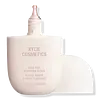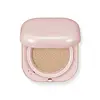What's inside
What's inside
 Key Ingredients
Key Ingredients

 Benefits
Benefits

 Concerns
Concerns

 Ingredients Side-by-side
Ingredients Side-by-side

Water
Skin ConditioningIsododecane
EmollientDimethicone
EmollientTrimethylsiloxysilicate
EmollientPropanediol
SolventCetyl PEG/PPG-10/1 Dimethicone
EmulsifyingPentylene Glycol
Skin ConditioningPhenyl Trimethicone
Skin ConditioningSilica
AbrasiveSodium Chloride
MaskingDisteardimonium Hectorite
StabilisingDimethicone Crosspolymer
Emulsion StabilisingMagnesium Sulfate
Sodium Dehydroacetate
PreservativePotassium Sorbate
PreservativeEthylene Brassylate
MaskingPropylene Carbonate
SolventMica
Cosmetic ColorantC24-28 Alkyl Methicone
EmollientTriethoxycaprylylsilane
Sodium Hyaluronate
HumectantAluminum Hydroxide
EmollientPentaerythrityl Tetra-Di-T-Butyl Hydroxyhydrocinnamate
AntioxidantCI 77891
Cosmetic ColorantIron Oxides
CI 77163
Cosmetic ColorantWater, Isododecane, Dimethicone, Trimethylsiloxysilicate, Propanediol, Cetyl PEG/PPG-10/1 Dimethicone, Pentylene Glycol, Phenyl Trimethicone, Silica, Sodium Chloride, Disteardimonium Hectorite, Dimethicone Crosspolymer, Magnesium Sulfate, Sodium Dehydroacetate, Potassium Sorbate, Ethylene Brassylate, Propylene Carbonate, Mica, C24-28 Alkyl Methicone, Triethoxycaprylylsilane, Sodium Hyaluronate, Aluminum Hydroxide, Pentaerythrityl Tetra-Di-T-Butyl Hydroxyhydrocinnamate, CI 77891, Iron Oxides, CI 77163
Water
Skin ConditioningCyclopentasiloxane
EmollientCI 77891
Cosmetic ColorantPhenyl Trimethicone
Skin ConditioningHomosalate
Skin ConditioningGlycerin
HumectantEthylhexyl Methoxycinnamate
UV AbsorberTitanium Dioxide
Cosmetic ColorantPEG-10 Dimethicone
Skin ConditioningCyclohexasiloxane
EmollientBoron Nitride
AbsorbentTrimethylsiloxysilicate
EmollientNiacinamide
SmoothingLauryl PEG-10 Tris(Trimethylsiloxy)Silylethyl Dimethicone
EmulsifyingPropanediol
SolventPolymethyl Methacrylate
1,2-Hexanediol
Skin ConditioningAcrylates/Dimethicone Copolymer
Skin ConditioningDisteardimonium Hectorite
StabilisingCI 77492
Cosmetic ColorantSodium Chloride
MaskingAlumina
AbrasiveCI 77163
Cosmetic ColorantGlyceryl Stearate Citrate
EmollientPolysorbate 80
EmulsifyingDisodium Stearoyl Glutamate
CleansingParfum
MaskingAluminum Hydroxide
EmollientDimethicone/PEG-10/15 Crosspolymer
Caprylyl Glycol
EmollientCI 77491
Cosmetic ColorantHydrogenated Lecithin
EmulsifyingEthylhexyl Hydroxystearate
EmollientSimethicone
EmollientGlyceryl Caprylate
EmollientEthylhexylglycerin
Skin ConditioningCI 77499
Cosmetic ColorantDisodium EDTA
Adenosine
Skin ConditioningTriethoxycaprylylsilane
Citronellol
PerfumingGeraniol
PerfumingLimonene
PerfumingDipropylene Glycol
HumectantBHT
AntioxidantHydroxycitronellal
PerfumingThymol Trimethoxycinnamate
AntioxidantSodium Citrate
BufferingTocopherol
AntioxidantSodium Benzoate
MaskingLactic Acid
BufferingPotassium Sorbate
PreservativeDiamond Powder
AbrasiveXanthan Gum
EmulsifyingWater, Cyclopentasiloxane, CI 77891, Phenyl Trimethicone, Homosalate, Glycerin, Ethylhexyl Methoxycinnamate, Titanium Dioxide, PEG-10 Dimethicone, Cyclohexasiloxane, Boron Nitride, Trimethylsiloxysilicate, Niacinamide, Lauryl PEG-10 Tris(Trimethylsiloxy)Silylethyl Dimethicone, Propanediol, Polymethyl Methacrylate, 1,2-Hexanediol, Acrylates/Dimethicone Copolymer, Disteardimonium Hectorite, CI 77492, Sodium Chloride, Alumina, CI 77163, Glyceryl Stearate Citrate, Polysorbate 80, Disodium Stearoyl Glutamate, Parfum, Aluminum Hydroxide, Dimethicone/PEG-10/15 Crosspolymer, Caprylyl Glycol, CI 77491, Hydrogenated Lecithin, Ethylhexyl Hydroxystearate, Simethicone, Glyceryl Caprylate, Ethylhexylglycerin, CI 77499, Disodium EDTA, Adenosine, Triethoxycaprylylsilane, Citronellol, Geraniol, Limonene, Dipropylene Glycol, BHT, Hydroxycitronellal, Thymol Trimethoxycinnamate, Sodium Citrate, Tocopherol, Sodium Benzoate, Lactic Acid, Potassium Sorbate, Diamond Powder, Xanthan Gum
 Reviews
Reviews

Ingredients Explained
These ingredients are found in both products.
Ingredients higher up in an ingredient list are typically present in a larger amount.
Aluminum Hydroxide is a form of aluminum. It can be naturally found in nature as the mineral gibbsite. In cosmetics, Aluminum Hydroxide is used as a colorant, pH adjuster, and absorbent.
As a colorant, Aluminum Hydroxide may add opacity, or reduce the transparency. Aluminum hydroxide is contains both basic and acidic properties.
According to manufacturers, this ingredient is an emollient and humectant. This means it helps hydrate the skin.
In medicine, this ingredient is used to help relieve heartburn and help heal ulcers.
There is currently no credible scientific evidence linking aluminum hydroxide in cosmetics to increased cancer risk.
Major health organizations allow the use of aluminum hydroxide in personal care products and have not flagged it as a carcinogenic risk at typical usage levels.
Learn more about Aluminum HydroxideThis synthetic powder is used to add a pearly/white color in cosmetics.
Ci 77891 is a white pigment from Titanium dioxide. It is naturally found in minerals such as rutile and ilmenite.
It's main function is to add a white color to cosmetics. It can also be mixed with other colors to create different shades.
Ci 77891 is commonly found in sunscreens due to its ability to block UV rays.
Learn more about CI 77891Disteardimonium Hectorite comes from the clay mineral named hectorite. It is used to add thickness to a product.
It can also help stabilize a product by helping to disperse other ingredients.
Hectorite is a rare, white clay mineral.
Learn more about Disteardimonium HectoritePhenyl Trimethicone is a silicon-based polymer. It is derived from silica.
Phenyl Trimethicone is used as an emollient and prevents products from foaming.
As an emollient, it helps trap moisture in the skin. It is considered an occlusive.
Learn more about Phenyl TrimethiconePotassium Sorbate is a preservative used to prevent yeast and mold in products. It is commonly found in both cosmetic and food products.
This ingredient comes from potassium salt derived from sorbic acid. Sorbic acid is a natural antibiotic and effective against fungus.
Both potassium sorbate and sorbic acid can be found in baked goods, cheeses, dried meats, dried fruit, ice cream, pickles, wine, yogurt, and more.
You'll often find this ingredient used with other preservatives.
Learn more about Potassium SorbatePropanediol is an all-star ingredient. It softens, hydrates, and smooths the skin.
It’s often used to:
Propanediol is not likely to cause sensitivity and considered safe to use. It is derived from corn or petroleum with a clear color and no scent.
Learn more about PropanediolChances are, you eat sodium chloride every day. Sodium Chloride is also known as table salt.
This ingredient has many purposes in skincare: thickener, emulsifier, and exfoliator.
You'll most likely find this ingredient in cleansers where it is used to create a gel-like texture. As an emulsifier, it also prevents ingredients from separating.
There is much debate on whether this ingredient is comedogenic. The short answer - comedogenic ratings don't tell the whole story. Learn more about comegodenic ratings here.
The concensus about this ingredient causing acne seems to be divided. Research is needed to understand if this ingredient does cause acne.
Scrubs may use salt as the primary exfoliating ingredient.
Learn more about Sodium ChlorideTriethoxycaprylylsilane is a silicone used to bind and stabilize ingredients.
As an emulsifier, it helps prevent ingredients from separating. This can help elongate the shelf life of products.
Triethoxycaprylylsilane is often used to coat mineral sunscreens ingredients to help give a better feel. It also helps reduce oxidative stress in sunscreens.
Learn more about TriethoxycaprylylsilaneThis silicone is an emollient. Emollients create a thin film on the skin to prevent moisture from escaping.
It is not soluble in water and helps increase water-resistance in products.
According to a manufacturer, it can blend seamlessly with silicone oils, such as Cyclopentasiloxane.
Learn more about TrimethylsiloxysilicateWater. It's the most common cosmetic ingredient of all. You'll usually see it at the top of ingredient lists, meaning that it makes up the largest part of the product.
So why is it so popular? Water most often acts as a solvent - this means that it helps dissolve other ingredients into the formulation.
You'll also recognize water as that liquid we all need to stay alive. If you see this, drink a glass of water. Stay hydrated!
Learn more about Water